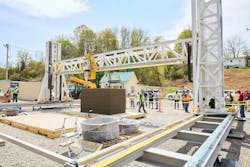Alquist, the construction company that built the first 3D printed house in Virginia, as well as Habitat for Humanity’s first occupied 3D printed home, has announced their latest venture: Two-hundred affordable homes across rural Virginia.
To kick off Project Virginia, Alquist began construction of the initial two 3D printed homes in Pulaski, Va. This was following the company’s project announcement event at the end of last April.
Zack Mannheimer, founder & CEO of Alquist, aims to print several of these Virginia homes by the end of the year, while also beginning projects in at least four other states (though specific numbers are TBD).
3D PRINTING HOMES THAT ARE AFFORDABLE
Alquist’s mission is to solve the housing shortage in rural and underserved areas of America. Utilizing the power of the NextCon printer—developed by key partner Black Buffalo 3D—Alquist looks to save 30% off the cost of a traditional house in the next two years.
Today, the savings of a 3D printed home aren’t as significant—about 5-10% in savings, according to Mannheimer. Even still, the current need for affordable housing is extreme, and Alquist wants to be a driver of change.
3D printed construction methods allow builders to work faster and build more, according to the company. The liquid cement exterior walls of a three-bedroom, one-story house can be printed in less than two days—shaving weeks off the homebuilding process.
So not only are they affordable, but efficient as well. Alquist estimates that its printing methods shave two to three weeks off from a standard construction schedule, cutting costs by nearly 15%.
That’s what rural Virginia needs, according to Mannheimer, and it's why he’s chosen the state for this project.
PROJECT VIRGINIA: WHY CHOOSE THE LOVERS’ STATE?
Pulaski, Va. specifically has a high demand for housing after Volvo, Blue Star Manufacturing, and American Glove Innovations moved in to create over 3,000 jobs.
Mannheimer envisions the Pulaski development with amenities, community centers, walkability, and unique spaces that serve the needs of folks who live there.
“When we first announced the [Habitat for Humanity] home, we were averaging 100 requests per hour,” says Mannheimer during his presentation at the 3D Printed Housing Conference. “It illustrates how extreme the need is for affordable housing.”
On top of launching Project Virginia, Alquist is looking into other methods of solving the housing crisis, such as modular and panelization. The methods might just blend well with Alquist’s current 3D printing methods, according to Mannheimer.
The CEO also wants to eventually get away from using liquid concrete in Alquist’s printing. The change would mean swapping for a greener material, such as hemp, plant-based materials, or recycled glass/plastics. Mannheimer says he’s been working with several universities on potential designs, but nobody’s able to figure it out quite yet.
The ultimate goal: Sustainable and affordable housing for everyone.
Mannheimer is also the CEO of Atlas Community Studios, an economic and workforce development agency for rural areas. Through that work, he’s learned these communities share a common challenge: “Inevitably, every community, regardless of size or location, has a housing shortage.”
